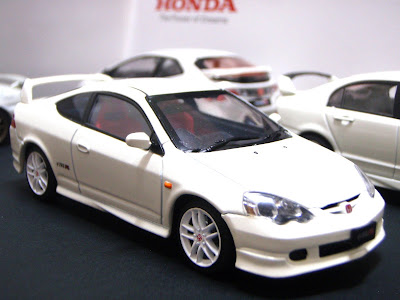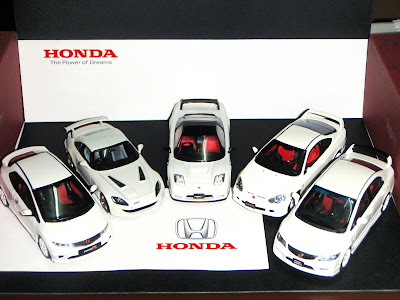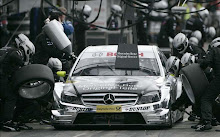Friday, September 16, 2011
Thursday, September 15, 2011
Friday, August 26, 2011
Honda S2000 Mugen
The standard Honda S2000s have been powered by the 2.2-liter F22C engine. Mugen engineers didn't tamper too much with the 242bhp engine itself. They just tuned it slightly and bolted on a new exhaust manifold that's about nine pounds lighter, with much less flow restriction. The new design is claimed to result in a boost of around 5-horsepower.
Coupled to this is a new sports exhaust that gives a mean-yet-melodic growl, especially under load.
What you get is a well-balanced, subtly aggressive sports car that's rewarding to drive and will keep pace with rides costing thousands more.
Coupled to this is a new sports exhaust that gives a mean-yet-melodic growl, especially under load.
What you get is a well-balanced, subtly aggressive sports car that's rewarding to drive and will keep pace with rides costing thousands more.
Friday, August 12, 2011
Integra Type R - A street racer's "Dream"
The Honda Integra DC5 Type R is powered by a 2.0-liter DOHC I-VTEC engine developed specifically for excellent intake and exhaust efficiency with a maximum power output of 220PS this is coupled with a new close-ratio 6-speed manual transmission. The new K20A Engine also combines the high-rev intake/exhaust valve timing and lift variability of VTEC technology with VTC (variable timing control) to achieve a maximum power output of 220PS. The re-designed Engine is approximately 10kg lighter than the B18C Type R engine.
Honda's developed close-ratio 6-speed manual transmission uses multiple synchronizing cones for all gears, including a triple-cone synchronizer in 1st and 2nd gears and a double-cone synchronizer in 3rd through 6th gears.
The Honda Integra DC5 Type R has an ultra-lightweight forged chrome-molybdenum steel flywheel fitted. A lightened and balanced flywheel makes the car more responsive and gives instant power when the driver accelerates.With such package, it requires minimal modification to convert into a racing car.
Honda's developed close-ratio 6-speed manual transmission uses multiple synchronizing cones for all gears, including a triple-cone synchronizer in 1st and 2nd gears and a double-cone synchronizer in 3rd through 6th gears.
The Honda Integra DC5 Type R has an ultra-lightweight forged chrome-molybdenum steel flywheel fitted. A lightened and balanced flywheel makes the car more responsive and gives instant power when the driver accelerates.With such package, it requires minimal modification to convert into a racing car.
NSX-R - "Dream" to create a world-class sports car.
The NSX is a driver oriented car, a truly masterpiece creation by Honda.
Development
When Honda introduced the NSX in 1990, they set out to establish a new concept in sports car value. Within the broader sports car category that included everything from small to large displacement vehicles, they offered the NSX, having a mid-engine, three-liter, normally-aspired engine and an all aluminum body construction. They also offered a commitment toward exhaust emission levels that responded strongly to environmental concerns. These advances all originated in Honda's desire to create a new, distinctive set of values in high-performance driving.
And now the NSX has entered a new phase of evolution. Its advanced styling and wider tires propel it to news heights in speed. Ten years after the introduction of the original NSX-R, Honda's objective is delivering new aerodynamic technologies to achieve a level of stability beyond earlier designs.
Aerodynamics
Honda have channeled their efforts towards increased high-speed stability and improved aerodynamics. At the rear down force is created by a carbon fiber spoiler. At the front, large aerodynamic devices were left off as they adversely effect ground clearance. Instead Honda redesigned the underbody of the car to be as flat as possible to encourage smooth airflow and promote down force.
Taking advantage of the of the car's mid-ship layout, an air duct was added in the hood to provide the necessary extraction route for the front radiator. Longitudinal fins were also added to the outer left and right sides of the under body cover to prevent air passing under the car, entering though the wheel wells. Similarly, spats have been added to channel air passing through the ducts, away from the wheel wells. These devices result in smoother airflow under the body, achieving the desired down force.
Handling
By contributing to high-speed stability, the aerodynamically induced down force achieved in the NSX-R has forced a selection of harder suspension settings which increase cornering performance. Overall the suspension is tuned to promote higher cornering limits. Increased damping rates, larger stabilizer bars, reinforced damper mounts and rear control arm bushings make for a more responsive drive.
The limited slip differential has been tuned as has body rigidity with strut tower bars.
Honda's quest for high cornering speeds led them to develop a custom, asymmetrically patterned Potenza R070. Repeated Suzuka Circuit testing during the tire's development laid the groundwork for detailed balancing of the tire grip in tune with the balance of the suspension settings. Lightweight wheels were developed together with BBS.
Significant improvements were achieved in the braking systems, specifically resistance to high temperature and fade. The hydraulic assistance has been increased and the ABS has been tuned to match the harder suspension settings.
Powertrain
Drawing upon acquired knowledge from the Japanese GT Championship, precision production methods were adopted to create a better engine feedback. Honda improved the feeling of linearity between throttle operation and the resultant variation in torque output.
The NSX-R employs the same high precision balancing as found in the race engines at the JGTC. Qualified technicians check each assembly, including clutch cover, fly wheel and pulleys. Rotating weight tolerance is reduced to below 1/10 that of the base NSX. Weight tolerances of the piston and connecting rods pairs are controlled to within half that of the base model.
Weight Reduction
Over the years Honda has continued to pursue weight reduction in the NSX. The design of the NSX-R incorporates weight reduction technologies achieved through the evolution of the base model. For the second generation NSX, Honda have employed fixed headlights, stainless exhausts and thinner exterior panels. Weight reduction specific to the NSX-R include carbon fiber aerodynamic devices, Recaro Bucket Seats, Momo steering wheel, no sound insulation, smaller battery, no power locks or doors, no hydrualic clutch damper, non-powered mirrors with air conditioning, audio and airbags being optional. These elements lower the weight of NSX-R by 78 kgs (172 lbs).
Development
When Honda introduced the NSX in 1990, they set out to establish a new concept in sports car value. Within the broader sports car category that included everything from small to large displacement vehicles, they offered the NSX, having a mid-engine, three-liter, normally-aspired engine and an all aluminum body construction. They also offered a commitment toward exhaust emission levels that responded strongly to environmental concerns. These advances all originated in Honda's desire to create a new, distinctive set of values in high-performance driving.
And now the NSX has entered a new phase of evolution. Its advanced styling and wider tires propel it to news heights in speed. Ten years after the introduction of the original NSX-R, Honda's objective is delivering new aerodynamic technologies to achieve a level of stability beyond earlier designs.
Aerodynamics
Honda have channeled their efforts towards increased high-speed stability and improved aerodynamics. At the rear down force is created by a carbon fiber spoiler. At the front, large aerodynamic devices were left off as they adversely effect ground clearance. Instead Honda redesigned the underbody of the car to be as flat as possible to encourage smooth airflow and promote down force.
Taking advantage of the of the car's mid-ship layout, an air duct was added in the hood to provide the necessary extraction route for the front radiator. Longitudinal fins were also added to the outer left and right sides of the under body cover to prevent air passing under the car, entering though the wheel wells. Similarly, spats have been added to channel air passing through the ducts, away from the wheel wells. These devices result in smoother airflow under the body, achieving the desired down force.
Handling
By contributing to high-speed stability, the aerodynamically induced down force achieved in the NSX-R has forced a selection of harder suspension settings which increase cornering performance. Overall the suspension is tuned to promote higher cornering limits. Increased damping rates, larger stabilizer bars, reinforced damper mounts and rear control arm bushings make for a more responsive drive.
The limited slip differential has been tuned as has body rigidity with strut tower bars.
Honda's quest for high cornering speeds led them to develop a custom, asymmetrically patterned Potenza R070. Repeated Suzuka Circuit testing during the tire's development laid the groundwork for detailed balancing of the tire grip in tune with the balance of the suspension settings. Lightweight wheels were developed together with BBS.
Significant improvements were achieved in the braking systems, specifically resistance to high temperature and fade. The hydraulic assistance has been increased and the ABS has been tuned to match the harder suspension settings.
Powertrain
Drawing upon acquired knowledge from the Japanese GT Championship, precision production methods were adopted to create a better engine feedback. Honda improved the feeling of linearity between throttle operation and the resultant variation in torque output.
The NSX-R employs the same high precision balancing as found in the race engines at the JGTC. Qualified technicians check each assembly, including clutch cover, fly wheel and pulleys. Rotating weight tolerance is reduced to below 1/10 that of the base NSX. Weight tolerances of the piston and connecting rods pairs are controlled to within half that of the base model.
Weight Reduction
Over the years Honda has continued to pursue weight reduction in the NSX. The design of the NSX-R incorporates weight reduction technologies achieved through the evolution of the base model. For the second generation NSX, Honda have employed fixed headlights, stainless exhausts and thinner exterior panels. Weight reduction specific to the NSX-R include carbon fiber aerodynamic devices, Recaro Bucket Seats, Momo steering wheel, no sound insulation, smaller battery, no power locks or doors, no hydrualic clutch damper, non-powered mirrors with air conditioning, audio and airbags being optional. These elements lower the weight of NSX-R by 78 kgs (172 lbs).
Theme: "Honda: The Power of Dreams"
I'm admiring Honda's dedication, commitment, on going effort and time to create some of the finest race machines out there. All these success come from the word "Dream". Let put the sequence together: dream -> create*** -> test*** -> race = success.
Thus, their "Power of Dream" had attracted me to start collecting some of the Type R/ Mugen models available out there. Now I'm trying very hard to impart the great spirit of late Mr.Soichiro Honda to fulfill some of my personal goals.
Subscribe to:
Comments (Atom)



























































